Quick Summary
This guide explains all common baby & infant sock types, how to measure and size correctly, what stay-on designs actually work, materials for summer vs. winter, and when to use grip socks for early steps.
Introduction
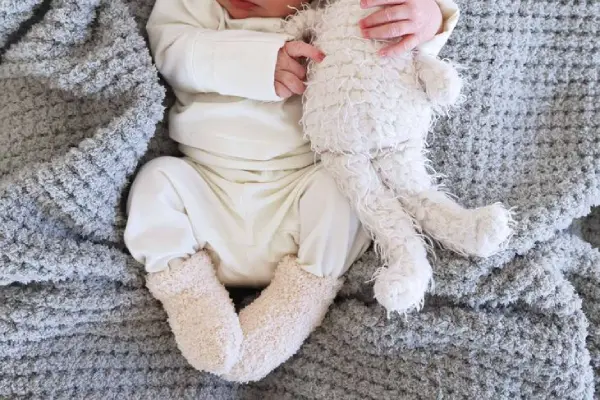
Infant socks may look like tiny accessories, but they play a surprisingly big role in a child’s comfort, safety, and style. From newborn days when warmth and softness matter most, to toddler years when grip and durability are essential, socks evolve alongside your baby’s growth.
This guide breaks down everything parents need to know about infant sock types—sizes, fabrics, seasonal choices, functional designs, and even special occasion styles. Whether you’re shopping for everyday basics, infant walking socks, or adorable newborn Mary Jane socks for a photo shoot, you’ll find clarity and practical advice here.
Sock Types by Age & Use
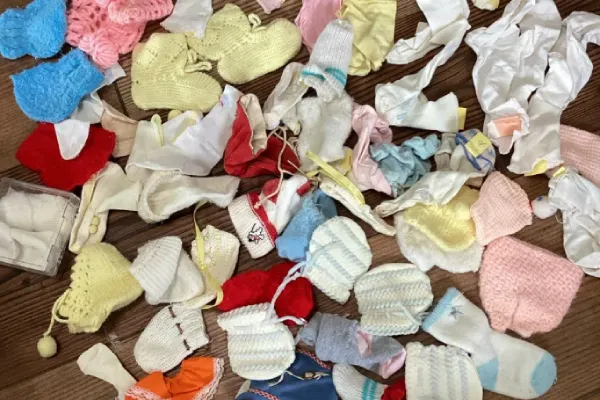
Newborn (0–3 months)
- Best for: warmth, photos, hospital-to-home.
- Go-to styles: booties or soft cuff crew/knee-high made from cotton or bamboo blends.
- Fit notes: choose a gentle cuff that leaves no marks on the skin; prioritize flat toe seams.
- Common mistake: buying “room to grow.” Oversized newborn socks bunch up and slide off.
Infant (3–12 months)
- Best for: rolling, sitting, and starting to crawl.
- Go-to styles: ankle or crew socks with smooth seams and light arch stretch.
- Fit notes: light elasticity keeps the sock in place without leaving ridges.
Crawler (6–12+ months)
- Best for: belly scooting, crawling, pulling-to-stand.
- Go-to styles: crew socks with deeper heel pocket; optional light outsole dots for traction on tile/wood.
- Fit notes: traction helps on slick floors, but keep the fabric thin and flexible.
Toddler (12–36 months)
- Best for: cruising, first steps, indoor play.
- Go-to styles: everyday crew/ankle for shoes; grip socks for indoor, barefoot use on hard floors.
- Fit notes: Inside shoes, use non-grip socks to avoid bunching. For grip recommendations, see our buyer’s list here: best non-slip toddler socks.
Sock Types by Design
- Ankle / Low-Cut
Minimal coverage, cooler in warm weather, great inside shoes. Look for a tab heel to help with on/off. - Crew / Mid-Calf
Everyday workhorse. The taller cuff reduces rubbing at the shoe collar and stays put better on active days. - Knee-High / Over-Calf
Added warmth and cuteness to outfits/uniforms. Mind the cuff pressure—it should hold without leaving marks. - Booties (Sock-Shoes / Crib Booties)
Soft, cozy “shoe-like” socks for newborns and young infants. Prioritize breathable uppers and no hard parts. - Ruffle / Lace / Decorative
Photo-friendly, but avoid small detachable ornaments for safety. For daily wear, stick to simple trims.
Stay-On Sock Designs: What Really Works
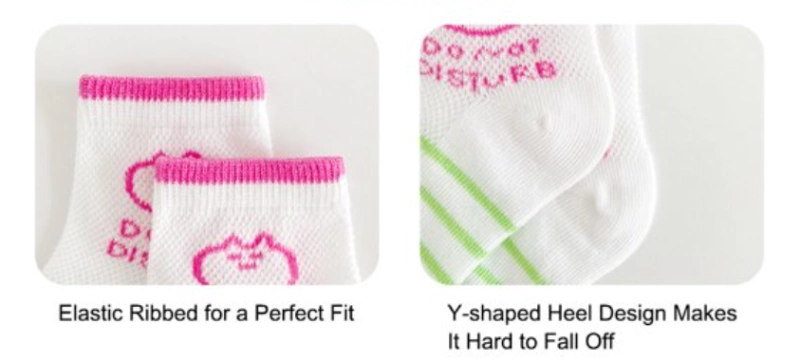
If socks slide off or twist underfoot, check these three areas:
- Structure
- Seek a deep heel pocket + Y-shaped heel seam so the sock grabs the heel.
- A light arch band adds midfoot “hug” without squeezing.
- Cuffs: two-stage (double) cuffs stay put better than single loose ribs.
- Sizing
- Too large = bunching at toes/arch → slips off.
- Too small = tight cuff marks, heel drops underfoot.
- If between sizes, follow the brand chart and favor the size that yields a snug, flat footprint.
- Materials
- Cotton/bamboo with a touch of spandex (2–5%) keeps its recovery after washing.
- After laundering, do a quick stretch-return test: pull the cuff and release—it should rebound promptly.
Micro-routine to stop “flying socks”: dry the ankle fully → align heel pocket with the heel → smooth the forefoot to remove toe bunching → check for no red marks after 10–15 minutes.
Baby Sock Size Guide: Measure & Convert
Choosing the right size isn’t just about comfort—it’s about safety. Socks that are too tight can restrict circulation, while socks that are too loose slip off easily.
How to Measure (60-second method)
- Stand or press heel to a wall on paper (for pre-walkers, gently extend the foot).
- Mark the longest toe and the back of the heel, then measure in cm (and inches).
- Measure both feet; use the larger number.
- Add a growth allowance of ~0.3–0.5 cm for socks (less than shoes).
- Cross-check with the brand’s official chart if available.
Here’s a stage-by-stage look
Sizes vary by brand. Use this as a starting point, then confirm with the product chart. “Fit note” favors a snug footprint for better stay-on performance.
- Newborn Socks (0–3 Months)
Newborn feet are delicate, so socks at this stage should be ultra-soft, stretchy, and gentle on sensitive skin. Options like newborn Mary Jane socks add a touch of charm while still keeping comfort first. - Infant Socks (3–12 Months)
At this stage, babies are more active. Parents often struggle with socks slipping off. Look for stay-on designs, such as elasticized cuffs that don’t dig into the skin. - Toddler Socks (12–24 Months)
As babies begin standing and walking, grip becomes essential. Infant walking socks and rubber sole socks for babies provide traction that supports early mobility. - Preschool Socks (2–3 Years)
Toddlers at this age are on the move. Breathable, durable socks are key—think cotton blends or bamboo fabrics that balance comfort with long wear.
| Age Range | Approx. Shoe Size | Key Needs / Features | Example Styles & Keywords |
|---|---|---|---|
| Newborn (0–3 mo) | 0–1 | Ultra-soft, gentle, stay-on without pressure | Newborn Mary Jane socks, ultra-soft cotton |
| Infant (3–12 mo) | 1–3 | Secure fit, stretch cuffs, won’t slip off | Stay-on socks, elasticized baby socks |
| Toddler (12–24 mo) | 3–6 | Grip, traction, safe for first steps | Infant walking socks, rubber sole socks, baby slipper socks |
| Preschool (2–3 yr) | 6–8 | Durable, breathable, suitable for play | Cotton blends, bamboo toddler socks |
Fit tips
- Inside shoes: pick thin, non-grip socks to avoid friction and wrinkles.
- At home on hard floors: thin grip socks can help stability (see When to Use Grip Socks).
- Wide feet/high instep: look for stretch content (spandex) and deeper heel pockets.
Fabric and Comfort Considerations

Material choice is crucial in infant socks. Babies’ skin is thinner and more prone to irritation, so the wrong fabric can cause discomfort.
- Cotton: Breathable, soft, and widely available. Best for everyday socks.
- Bamboo / Viscose from Bamboo: Naturally hypoallergenic, moisture-wicking, and eco-friendly.
- Blends: Cotton-polyester blends improve durability and stretch.
- Specialized fabrics: Some socks feature aloe-infused or antimicrobial fibers for extra skin protection.
When shopping, look for hypoallergenic baby socks or organic cotton baby socks if your child has sensitive skin. Above all, prioritize softness—comfortable socks help keep babies happy and fuss-free.
How to Choose the Right Socks for Every Stage
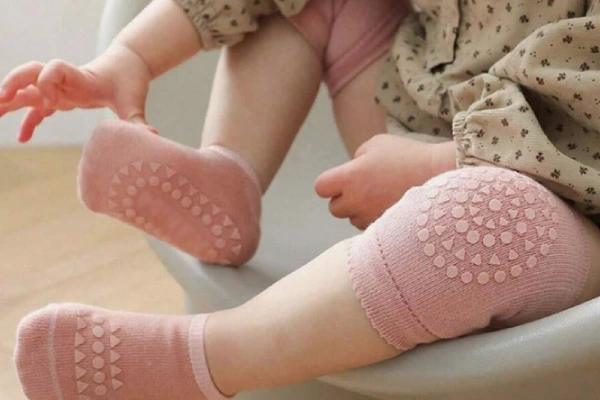
Building a Starter Sock Wardrobe (0–6 Months)
Start with a mix of everyday socks and a few decorative pairs like newborn Mary Jane socks for special occasions.
Balancing Function and Style (6–12 Months)
Crawling babies need socks that stay on. Grip socks or stylish infant ballerina socks strike the right balance between practicality and cuteness. For specific product picks and use-cases, see our buying list: Best Non-Slip Toddler Socks (2025). If you want labeling & safety basics (materials, care, flammability/label rules) in one place, read: Children’s Socks Safety & Certifications (Guide).
Supporting First Steps (12–24 Months)
For new walkers, infant walking socks, rubber sole socks, and baby slipper socks are essential. These designs reduce slips and encourage safe movement indoors.
Adding Seasonal and Special Occasion Styles (2–3 Years)
As your child grows, rotate seasonal options (warm socks for winter, breathable socks for summer) and sprinkle in festive or photo-ready pairs for milestones.
| Age Stage | Key Needs / Focus | Recommended Sock Types & Examples |
|---|---|---|
| 0–6 Months | Comfort, softness, warmth, occasional dress-up | Everyday baby socks, newborn Mary Jane socks (special occasions) |
| 6–12 Months | Stay-on designs, balance of function + style | Grip socks, infant ballerina socks (practical yet cute) |
| 12–24 Months | Safety for first steps, traction, mobility | Infant walking socks, rubber sole socks, baby slipper socks |
| 2–3 Years | Seasonal variety, playful + festive styles | Warm winter socks, breathable summer socks, special occasion socks (photo-ready) |
Care and Maintenance Tips
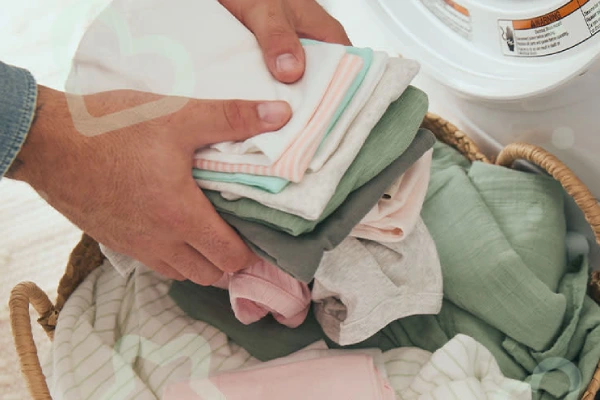
Babies go through socks much faster than parents expect—between spills, drool, and the inevitable vanishing sock, it’s smart to keep a base of 8–12 pairs on hand. This ensures there are always fresh options ready without constant laundry.
Washing & Drying:
- Use mild detergent and a delicate cycle to protect fabrics.
- Avoid harsh fabric softeners, which reduce absorbency.
- Air drying keeps socks soft the longest, though a low-heat tumble is a practical alternative.
Dealing with Lost or Outgrown Socks:
- Repurpose singles into dust mitts, toy pouches, or DIY crafts.
- Donate or pass on outgrown socks to extend their life cycle.
- These small steps align with the eco-friendly baby socks trend and sustainable parenting.
For Brands & Retailers:
Promote eco-friendly fabrics + aftercare solutions to strengthen your brand’s green narrative and loyalty among modern parents. Offer care guides with packaging to add value for parents. Sell bundle sets that match real household needs (8–12 pairs). Explore sock recycling or trade-in programs as a sustainability initiative.
FAQ Section
Should newborn babies wear socks?
Yes, newborns often need socks to keep their feet warm, as they cannot regulate body temperature well. Soft, breathable fabrics are best for comfort.
When to Use Grip Socks for your baby?
Grip socks (with silicone/rubber dots or pads) can help early cruisers and toddlers on hardwood/tile. They’re great for indoor play and some soft-play/trampoline venues that require them.
Inside shoes, prefer regular (non-grip) socks to prevent friction and sock migration.
When are knee-high socks useful?
Cooler weather, uniforms, photo outfits, or when you want extra hold under pants. Confirm cuff comfort for extended wear.
Is it better for babies to walk barefoot or with socks?
When learning to walk indoors, barefoot is ideal for balance. However, infant walking socks or grip socks provide protection and traction on slippery floors.
Should a baby’s feet be covered at night?
If the room is cool, lightweight socks can keep a baby comfortable. Overheating is a risk, so choose breathable fabrics and avoid thick socks at bedtime.
Conclusion
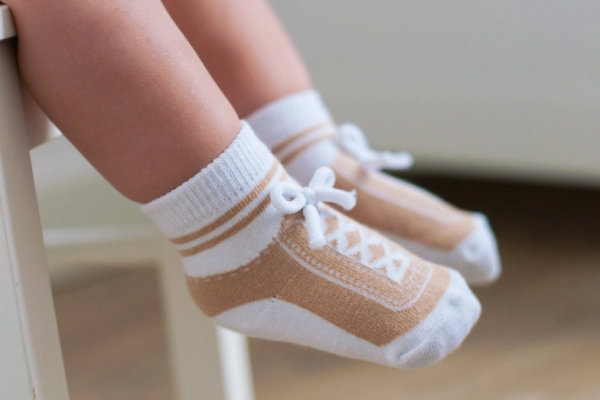
From newborn Mary Jane socks to infant walking socks, every stage of a baby’s growth calls for the right fit, fabric, and function. The right choices ensure comfort, safety, and style from day one.
Looking ahead, trends like personalized baby socks, eco-friendly fabrics, and bundled gift sets are transforming socks from simple essentials into meaningful keepsakes.
For brands and retailers, this is more than a parenting guide—it’s a market signal. Parents are actively searching for quality, sustainability, and creative value in baby socks. By offering eco-conscious materials, personalization options, and practical bundle packs, your business can capture that demand and stand out in a competitive market.
👉 Partner with trusted suppliers, explore custom designs, and make infant socks not just a product, but part of your brand story.t.
